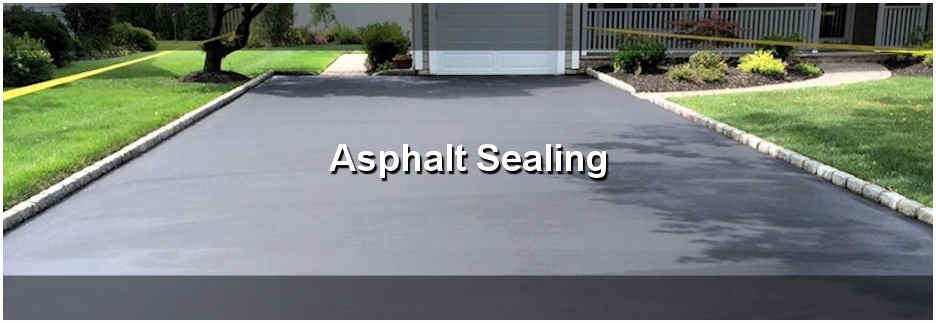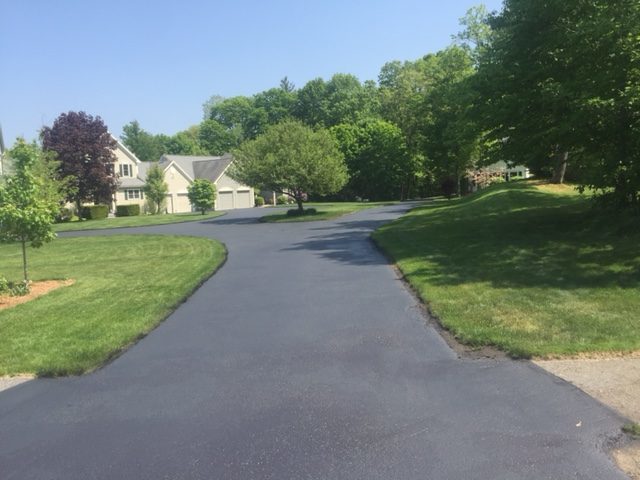Raise Commercial Allure: Hot Mix Asphalt Sealing for Angled Parking Lots
Raise Commercial Allure: Hot Mix Asphalt Sealing for Angled Parking Lots
Blog Article
Hot Mix Asphalt: A Sustainable Service for Sidewalk
Warm Mix Asphalt (HMA) has arised as a leading sustainable option for pavement services, providing a myriad of environmental advantages and innovative innovations. As the demand for green building and construction practices expands, exploring the nuances of HMA's sustainability can supply valuable insights right into the future of pavement services.
Environmental Benefits of Hot Mix Asphalt

Furthermore, Warm Mix Asphalt aids to mitigate urban warm island results. Its dark color soaks up sunlight, reducing the quantity of heat mirrored back into the ambience compared to lighter-colored sidewalks. This can reduce ambient temperatures in metropolitan locations, reducing the need for a/c and ultimately decreasing power consumption.
In enhancement, Warm Mix Asphalt contributes to enhanced stormwater management. Its porous nature enables water to penetrate the sidewalk and recharge groundwater materials, minimizing overflow and the risk of flooding. These environmental advantages make Warm Mix Asphalt a sustainable option for paving freeways and roads.
Energy Efficiency in HMA Production
Is energy effectiveness a vital consider the manufacturing of Warm Mix Asphalt (HMA)? Definitely. Energy plays a considerable role in the manufacturing of HMA, affecting both cost and environmental sustainability. One key element of energy performance in HMA manufacturing is the usage of warm mix asphalt (WMA) modern technologies (hot mix asphalt). WMA enables for the blending and placement of asphalt at reduced temperature levels compared to traditional hot mix asphalt, resulting in lowered energy usage during manufacturing. This process not only decreases fuel use yet additionally reduces greenhouse gas exhausts, making it an extra ecologically pleasant choice.
Additionally, improvements in plant innovations have actually resulted in more energy-efficient HMA production processes. Modern plants are created with attributes like recycled asphalt pavement (RAP) processing abilities, efficient burner systems, and boosted insulation, all adding to power savings. By maximizing power usage in HMA production, the industry can minimize its carbon impact while preserving top quality pavement products. Energy performance is, therefore, a critical consideration in making certain the sustainability of Hot Mix Asphalt manufacturing.
Recyclability of Warm Mix Asphalt
The recyclability of Warm Mix Asphalt (HMA) is a critical element of its sustainability and lasting ecological impact. HMA is among one of the most recycled materials in the United States, with over 100 million lots of recovered asphalt pavement (RAP) being recycled each year in brand-new pavement building. Recycling HMA uses several environmental advantages, such as minimizing the requirement for virgin products, decreasing energy intake during manufacturing, and decreasing the amount of waste sent to garbage dumps.
The procedure of recycling HMA entails milling the existing sidewalk, squashing it right into smaller sized pieces, and blending it with brand-new accumulation and asphalt binder to develop a recycled useful content mix. This recycled mix can commonly execute as well as or even much better than standard HMA, while click for source calling for less raw products and creating lower greenhouse gas emissions. By incorporating RAP into brand-new sidewalk jobs, road companies can conserve natural sources, minimize expenses, and reduce the environmental footprint of roadway building and construction and upkeep activities. In general, the recyclability of HMA plays a considerable role in promoting lasting methods within the pavement industry.

Long-Term Performance of HMA
Asphalt pavements demonstrate longevity and resilience over an extended duration, mirroring the lasting efficiency of Warm Mix Asphalt (HMA) The durability of HMA can be credited to its capability to stand up to rush hour tons, extreme climate condition, and the impacts of aging. Research studies have shown that properly designed and correctly built HMA sidewalks can last for twenty years or even more with routine upkeep. The key to making the most of the long-lasting performance of HMA hinges on making use of high-quality products, complying with finest practices in construction, and implementing reliable maintenance techniques. Proper water drainage, regular evaluations, and timely fixings are necessary great post to read for protecting the structural honesty of HMA pavements over time. In addition, improvements in HMA technology, such as using polymer-modified binders and cozy mix asphalt, have further boosted the longevity and durability of HMA pavements. By prioritizing top quality building and maintenance practices, HMA proceeds to confirm itself as a lasting and cost-efficient service for lasting sidewalk facilities.

HMA: Sturdiness and Sustainability
Demonstrating both longevity and sustainability, Hot Mix Asphalt (HMA) has actually ended up being a cornerstone in the building and construction of lasting sidewalk infrastructures - angled parking. HMA's sturdiness originates from its capability to hold up against heavy tons, harsh weather condition conditions, and high web traffic quantities, making it a trustworthy choice for roads, freeways, and airport paths. The composition of HMA, which normally consists of aggregates, binder, and filler, plays a critical role in improving its long life and resistance to wear and tear
Moreover, HMA's sustainability hinges on its recyclability and energy-efficient manufacturing procedure. The ability to recycle recovered asphalt sidewalk (RAP) in brand-new HMA mixes minimizes the need for virgin materials and lessens the ecological impact of pavement building and construction and maintenance. Furthermore, the power efficiency of creating HMA depends on its reduced mixing temperature levels contrasted to various other pavement materials, causing reduced energy usage and greenhouse gas exhausts.
Conclusion
In conclusion, warm mix asphalt (HMA) uses a lasting service for sidewalk with its eco-friendly attributes. HMA's recyclability, power performance in manufacturing, and long-term toughness make it an environmentally friendly option for roadway building and construction. By conserving natural resources, reducing waste, and decreasing greenhouse gas discharges, HMA plays an essential function in promoting sustainability in infrastructure growth. Its ability to alleviate metropolitan heat island effects additionally underscores its importance in developing environmentally conscious and resistant sidewalk systems.
HMA is one of the most recycled products in the United States, with over 100 million tons of redeemed asphalt pavement (RAP) being reused each year in brand-new sidewalk construction.The procedure of recycling HMA entails grating the existing pavement, squashing it into smaller sized pieces, and blending it with new accumulation and asphalt binder to create a recycled mix.Asphalt sidewalks demonstrate resilience and strength over a prolonged period, showing the long-term efficiency of Hot Mix Asphalt (HMA) In addition, improvements in HMA technology, such as the usage of polymer-modified binders and cozy mix asphalt, have further boosted the sturdiness and longevity of HMA pavements. The capacity to recycle reclaimed asphalt sidewalk (RAP) in new HMA mixtures lowers the need for virgin materials and minimizes the ecological impact of pavement construction and upkeep.
Report this page